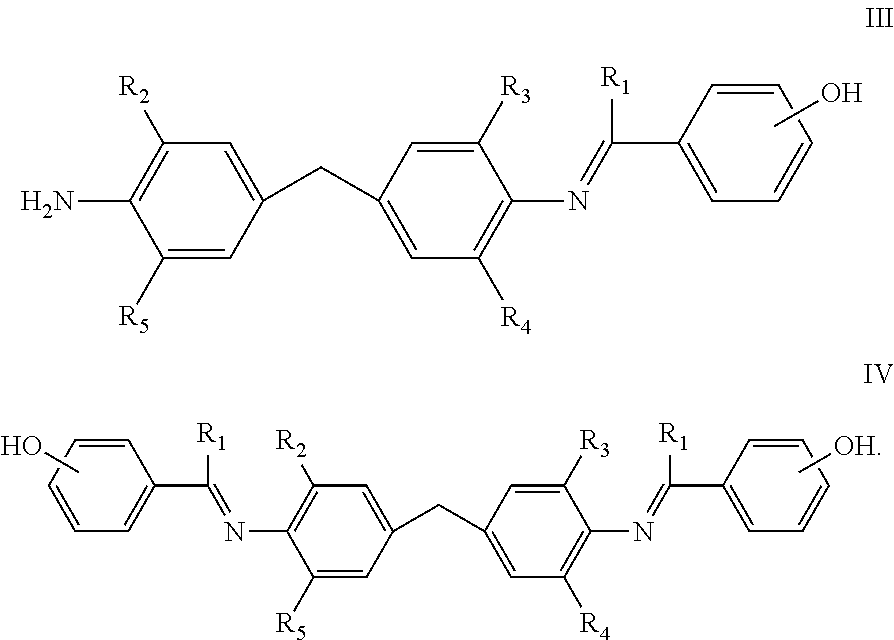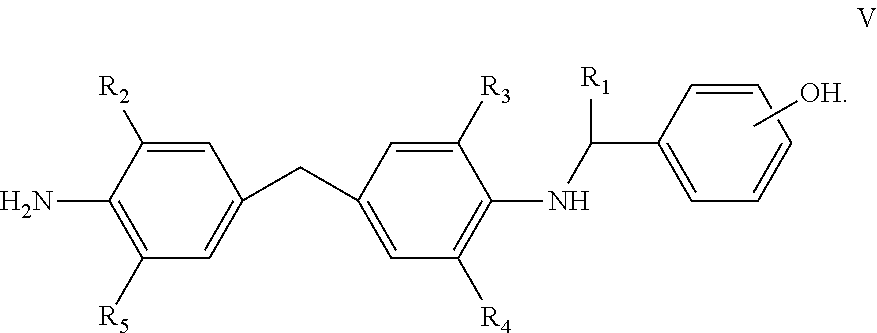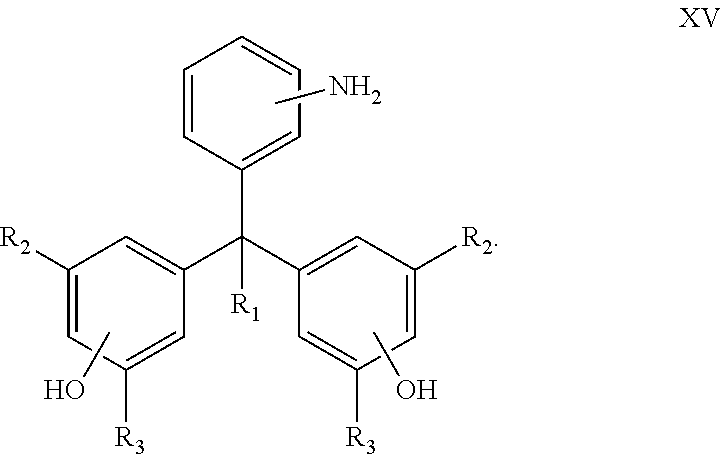Curing agents for epoxy resins
a technology of epoxy resin and cure agent, which is applied in the field of cure agents for epoxy resin, can solve the problems of tiny solder joints, thermo-mechanical expansion mismatch, and demand for smaller and more powerful electronic components, and achieve the effects of reducing the risk of health, and improving the pot li
- Summary
- Abstract
- Description
- Claims
- Application Information
AI Technical Summary
Benefits of technology
Problems solved by technology
Method used
Image
Examples
example 1
Synthesis of Compound 1
[0192]
[0193]Methylene-1,1-bis(2-isopropyl-6-methylaniline) (Lonzacure®, 31.1 g, 100 mmol available from Lonza Group of Switzerland), 4′-hydroxyacetophenone (13.6 g, 100 mmol), and toluene (50 ml) were added to a 2-neck, 500 ml flask. A Dean-Stark trap, condenser and bubbler were attached to one neck of the flask and a temperature controller probe was inserted into the other. The mixture was stirred and heated to 165° C. under an argon blanket. Approximately 35 ml of toluene originally charged into the flask was removed so that the temperature attains the 165° C. target reflux temperature. A total of 1.75 ml of water was collected (theory=1.8 ml) after twenty-four hours of reflux. The toluene was removed via rotary evaporation at 95-100° C. The product was then placed in an oven set at 130° C. for 4 hours to remove the last traces of residual solvent. The reaction yielded 42.3 g (98.8%) of a deep-red, glassy product.
[0194]The compound was subjected to thermogra...
example 2
Synthesis of Compound 2
[0195]
[0196]Methylene-1,1-bis(2-isopropyl-6-methylaniline) (Lonzacure®, 62.1 g, 200 mmol available from Lonza Group of Switzerland), 2′-hydroxyacetophenone (27.2 g, 200 mmol), and toluene (50 ml) were charged into a 2-neck, 500 ml flask. A Dean-Stark trap, condenser, and bubbler were attached to one neck and a temperature controller probe was attached to the other. An argon blanket was placed over the reaction mixture. The mixture was stirred and refluxed at 165° C. Approximately 35 ml of toluene were removed for the temperature to attain the 165° C. target reflux temperature. A total of 3.6 ml (equal to theory) of water was collected after 29.5 hours of reflux. The toluene was removed via rotary evaporation and air sparge, followed by vacuum oven treatment. The reaction yielded 85.6 g (99.9%) of an amber, glassy solid. The compound was subjected to TGA. The retained weight at 200° C. (TGA ramp rate=10° C. / min., air purge) was 99.7% and the decomposition onset...
example 3
Synthesis of Compound 3
[0197]
[0198]4,4′-Diamino-3,3′-diethyl diphenyl methane (25.4 g, 100 mmol), 4′-hydroxyacetophenone (13.6 g, 100 mmol), and toluene (50 ml) were added to a 2-neck flask. A Dean-Stark trap, condenser and bubbler were added. The mixture was refluxed for 13.3 hrs at 165° C. under an argon blanket. Approximately 35 ml of toluene were removed to drive the reflux temperature up to 165° C. A total of 1.8 ml of water (equivalent to theory) was collected. The toluene was removed via rotary evaporation, air sparge, and finally drying the product in an oven at 120° C. The product recovered consisted of 37.1 g (99.6%) of a reddish brown glassy solid. The compound was subjected to thermogravimetric analysis (TGA).
[0199]The retained weight at 200° C. (TGA ramp rate=10° C. / min., air purge) was 99.2% and the decomposition onset was at 273° C. The infrared spectrum of this compound included prominent absorptions at 2963, 1704, 1600, 1503, 1439, 1364, 1273, 1169, and 836 wavenumb...
PUM
| Property | Measurement | Unit |
|---|---|---|
| temperatures | aaaaa | aaaaa |
| temperatures | aaaaa | aaaaa |
| pressure | aaaaa | aaaaa |
Abstract
Description
Claims
Application Information
 Login to View More
Login to View More - R&D
- Intellectual Property
- Life Sciences
- Materials
- Tech Scout
- Unparalleled Data Quality
- Higher Quality Content
- 60% Fewer Hallucinations
Browse by: Latest US Patents, China's latest patents, Technical Efficacy Thesaurus, Application Domain, Technology Topic, Popular Technical Reports.
© 2025 PatSnap. All rights reserved.Legal|Privacy policy|Modern Slavery Act Transparency Statement|Sitemap|About US| Contact US: help@patsnap.com



